�
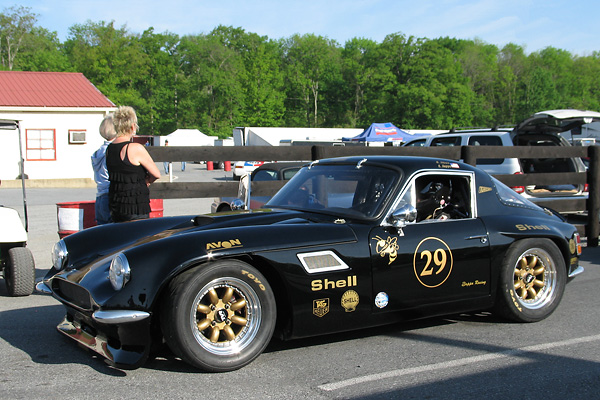
�
Michael Zappa's 1969 TVR Tuscan V6 Race Car
� � Owner: Michael Zappa� City: Pittsburgh Pennsylvania
� Model: 1969 TVR Tuscan
� Engine: 3.0L Ford V6
� Built by: Zappa Racing, MAP Automotive, and Boffo Motors
� Race Prepared by: Zappa Racing�
�
The TVR Tuscan Model
��
TVR is a small, specialist sportcar manufacturer that was founded in 1947 by Trevor �
Wilkinson and his partner Jack Pickard. The company started and operated for nearly its �
entire existance in the seaside town of Blackpool, which overlooks the Irish Sea. �
From 1953, TVR car models have usually featured fiberglass bodies mounted on top of �
tubular steel chassis.�
�
TVR's Tuscan model was built from 1967 to 1971. A second model produced through this�
same period is known as the Vixen. The two were cosmetically similar, but the Vixen model�
featured smaller and less powerful engines. The Tuscan and Vixen were preceded by �
various Grantura and Griffith models, and in the early seventies they were superseded�
by TVR's various "M" models.�
�
The Tuscan model was originally offered with Ford's 289 cubic inch V8 engine. Ultimately, �
seventy-three Tuscan V8's would be built. Compared to their rivals, a relatively high�
proportion of TVR sales were to British customers. The large American V8 engine may have �
been overkill for that market. Realizing this, in 1969 TVR began also offering British �
Ford's Essex 2994cc V6 in the Tuscan. The Essex V6 was rated 136hp, and with it �
the Tuscan was able to reach speeds of 125mph. 101 Tuscan V6's were built, bringing �
total Tuscan production to 174 cars.�
�
Please support the sponsoring companies who make www.BritishRaceCar.com possible, including:
� �
 �
�
�
�
Mike Zappa's Tuscan V6
��
Mike Zappa's first encounter with a TVR sports car happened when he was in high school.�
The year was 1966, and the car was a Ford 289 cubic inch V8 powered TVR Griffith 400. �
As much as he coveted it, he'd have to wait until college graduation before buying a�
TVR of his own. Then, Mike purchased a new 1972 TVR 2500M, which featured Triumph's �
2.5L inline six cylinder engine. Mike raced his 2500M through 1973 and 1974, before �
events conspired against his racing ambitions. Firstly, due to low sales volume, SCCA �
ruled that the 2500M failed to meet their homologation requirements. They would no �
longer classify it as a "production" automobile. At about the same time, young children �
were born into the Zappa household. �
�
The racing bug may have been forced into remission, but it didn't leave his system �
entirely. In 1991, Mike resumed racing. Through the nineties, Mike drove progressively faster�
classic Lotus models: a Lotus 18 (Formula Junior), Lotus 31 (Formula Three), Lotus 26R�
(racing version of the "Elan"), a Lotus Cortina, and a Lotus 23B. For a change of pace, �
Mike raced a spectacular Chevron B16 for about five years. Meanwhile, Mike also built-up �
and raced a Datsun 510. All these cars ultimately led back toward where he started. �
About five years ago Mike decided to build himself the ultimate vintage TVR racecar. �
�
Over the years Mike has owned about fifteen TVR sports cars. In addition to working on �
his own TVR's, he has also restored TVR sports cars for other people. When this particular �
car came along, he knew well how to judge whether it was suitable for restoration. It's a �
1969 TVR Tuscan, and it arrived as a basket case. Its tired and corroded tubular chassis �
was judged unsuitable for use or repair, so it was scrapped. The rest of the car was in �
pieces. This Tuscan had never been a racecar, but that would be its destiny.�
�
One of the first orders of business was acquisition of a suitable frame. Original�
TVR Tuscan frames were constructed of round tubing. In 1971, for the new "M" series,�
TVR developed new frame designs which combined round and box section tubing. The new �
style frames were easier to fabricate and much easier to attach body panels to, and �
they were also significantly more robust. Mike chose a 2500M frame as a foundation for �
this project. �
�
�
Enjoying this article? www.BritishRaceCar.com is partially funded through generous support from readers like you!
�
To contribute to our operating budget, please click here and follow the instructions.
�
(Suggested contribution is twenty bucks per year. Feel free to give more!)�
�
Ultimately, the frame would receive many modifications, including entirely custom front �
and rear suspension pick-up points. Much of his chassis work was subcontracted by �
Mike Zappa to his friend Mike Pierro. Mike Pierro is also located in the Pittsburgh area,�
where he specializes in restoration of Cobras and GT40's. His shop is known as �
MAP Automotive. MAP Automotive restored the TVR tubular chassis, built the rollcage, �
fitted the engine and radiator, and fabricated the custom exhaust headers. �
�
Another key partner in the Tuscan's construction was Jim Boffo of Boffo Motors in �
New Brighton, Pennsylvania. Boffo Motors is a full service sports car maintenance, �
repair, and restoration shop. Although Jim has many years of racing experience, his�
role in this Tuscan project was primarily bodywork. Indeed, some of the custom bodywork �
on this car is quite special and elaborate. Both front and rear fenders have been �
sectioned and made wider to fit wider tires. Boffo Motors also did modifications to �
the suspension and updates to the chassis beyond what Mike did. The TVR's exceptional �
paint job is entirely the work of Boffo Motors. �
�
Besides over-seeing all the construction work, Zappa Racing did the electrical, plumbing, �
interior, and aluminum work as well as assembly and shaking out. For example,�
they found and corrected a runout problem in the bellhousing which was causing rapid�
transmission failures. Now that the Tuscan is fully sorted, they're actively racing it and �
making continuous mechanical refinements.�
�
Since this TVR Tuscan project started, Zappa Racing has restored seven other TVR's, but �
this one is the fastest! Mike has also recently purchased and started restoration of a �
Ford GT40 Series I. Restoring an original Ford GT40 is a big financial commitment,�
requiring rare parts and specialized help. For example, the Ford V8 engine is currently �
being rebuilt by Holman Moody, who built it the first time back in the sixties. Thus, �
the Tuscan has been offered up for possible sale, priced at $110,000. It's certainly �
doubtful whether anyone could build an equally developed and refined Tuscan V6 for less �
�
� Please support the sponsoring companies who make www.BritishRaceCar.com possible, including:
� �
 �
�
�
�
Features and Specifications
�| Engine: | �3.0L Ford Essex V6, built to racing specification by Ric Wood Motorsport in England. �
Cosworth GAA engine block, sleeved down to achieve the required cylinder bore. �
Steel crankshaft. �
Cosworth forged aluminum pistons. �
Cosworth forged connecting rods.�
Approximately 13:1 static compression ratio. �
Ric Wood Motorsport (two valve per cylinder) aluminum cylinder heads. �
Group 1 camshaft with 320 degrees duration. �
1.95" inlet valves and 1.625" exhaust valves. �
Roller rockers. �
Custom intake manifold.�
Triple Weber 44 DCNF downdraught carburetors. �
Mallory distributor.�
Mallory ProMaster coil. �
Accel 8.8 Silicone Plus Spiral Core RFI suppression spark plug wires.�
MSD6AL capacitive discharge ignition system with rev-limiter set at 7200 rpm. �
(Actual shift point is ~6700 rpm, for engine longevity.)�
Ric Wood dry sump lubrication system, with remote tank located in cabin on passenger side. �
2 stage oil pump.�
Mocal remote oil filter mount, with Fram HP1 filter.�
Brad Penn 20/50 race oil with zinc additive. | �
| Cooling: | �custom Griffin aluminum radiator. (Water and "Water Wetter" only.) �
Remote mounted thermostat.�
Setrab oil cooler located under car with ducting from the front of car. | �
| Exhaust: | �custom headers with two 3-into-1 collectors and slip joints, custom fabricated by Mike Pierro. �
Dual straight pipes exiting out the rear of car. (No crossover pipe.) | �
| Transmission: | �Borg-Warner "World Class" T5z 5-speed with 0.80:1 fifth gear and special upgraded synchros. �
B&M short-throw shifter.�
Tilton clutch master cylinder. �
Tilton dual-disc 6.25" clutch, actuated by a Tilton hydraulic throw-out bearing.�
Aluminum flywheel. �
Ric Wood bellhousing.�
Custom driveshaft. | �
| Rear End: | �Chevrolet Corvette quick change rear end with limited slip differential.�
Modified heavy duty universal joints. | �
| Chassis: | �original round-tube 1969 TVR Tuscan frame has been replaced with a �
1970's vintage square-tube "M" chassis, which is much stronger. | �
| Front Susp.: | �upper and lower A-arms with Heim joints. �
Spax Krypton adjustable gas coil-over shock absorbers. �
Hypercoil springs.�
Triumph TR6 quick ratio steering rack (modified as shown below).�
Triumph TR6 uprights (modified) and steering arms (also modified).�
All pickup points gusseted.�
Speedway Engineering modular 1" adjustable sway bar, mounted on aluminum pillow blocks. | �
| Rear Susp.: | �upper and lower A-arms with Heim joints. �
Spax Krypton adjustable gas coil-over shock absorbers. �
Hypercoil springs.�
Reinforced aluminum hub carriers.�
All pickup points gusseted.�
Speedway Engineering modular adjustable sway bar, mounted on Heim joints. | �
| Brakes: | �(master) dual Girling master cylinders, with remotely adjustable bias bar. Castrol SRF hi-temp racing fluid. � (front) Outlaw calipers with Hawk HP100 pads. 10.75" Ford Thunderbird rotors. � (rear) Outlaw calipers with Hawk HP100 pads. 10.75" Ford Thunderbird rotors. Tilton brake bias valve. | �
| Wheels/Tires: | �3-piece aluminum racing wheels by Image Wheels International Ltd.�
Toyo Proxes R888/235/50/15 tires, unshaved. | �
| Electrical: | �Hawker lightweight racing dry cell battery. �
Mitsubishi alternator.�
Hella external battery disconnect switch.�
Working headlights, tail lights, and gauge lights. | �
| Instruments: | �(left to right) AutoMeter Sport-Comp tachometer (0-10000rpm), �
AutoMeter Sport-Comp oil pressure (0-100psi), �
fuel pressure (0-15psi, electronic), �
coolant temperature (140-280F),�
and oil temperature (140-280F) gauges. �
Westach single EGT (700-1700F) and dual EGT (700-1700F) gauges. �
Mico brake pressure (0-1500psi) gauges. �
Mr. Gasket fuel pressure gauge (0-15psi, mechanical) and �
Hobbes hour meter, located in the engine compartment. �
| �
| Fuel System: | �ATL 8 gallon fuel cell. �
Aston Martin fuel filler cap. �
Holley "red" fuel pump. �
Holley adjustable fuel pressure regulator.�
Mr. Gasket triple outlet fuel block. | �
| Safety Eqmt: | �9-Point gusseted roll cage.�
Kirkey 41V low back aluminum drivers seat. �
Simpson 5-point Cam-lok safety harness.�
Pegasus hex type quick release steering wheel hub, on a Momo steering wheel.�
Raydyot large bullet mirrors on custom fabricated aluminum brackets. �
S.P.A. Firefighter AFFF centralized fire suppression system. | �
| Weight: | �~2200 pounds, including driver (~190#) and fuel. | �
| Misc.: | �Special one-piece front clip.�
Lexan windows (all).�
Custom opening rear window. | �
| Racing Class: | �SVRA Group 8 / A-Production. | �
Engine Installation
��
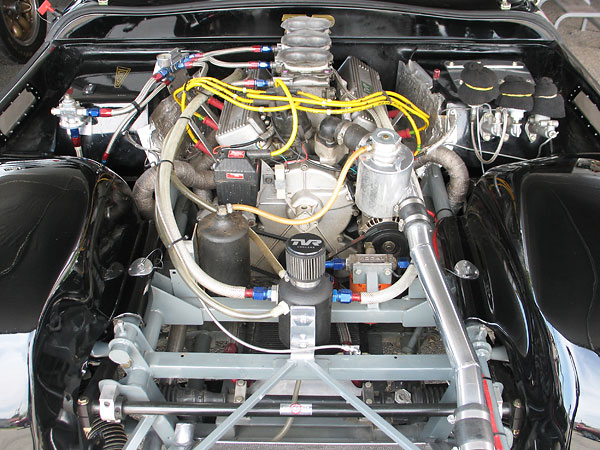
�
3.0L Ford Cosworth Essex V6, built by Ric Wood in England.
�
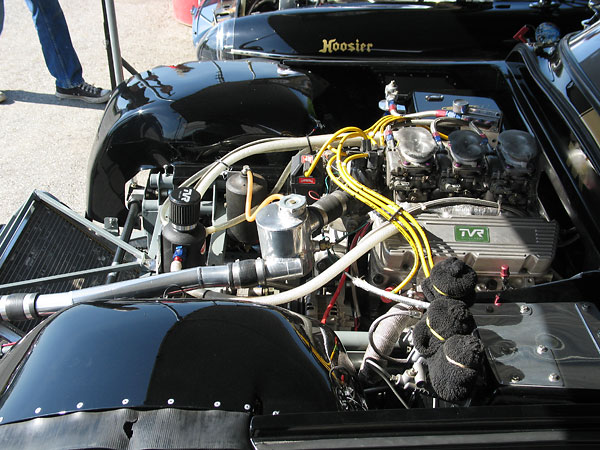
�
Ford originally planned to produce both gasoline and diesel versions of the Essex iron block, sixty-degree
�
V6. Diesel versions never reached production, but that goal is one reason the design is so robust. Later,
�
Ford worked with Cosworth to develop the Essex V6 for use in Capri RS3100 race cars with which they
�
contested Division 2 of the European Touring Car Championship, finishing second to BMW in 1974.
�
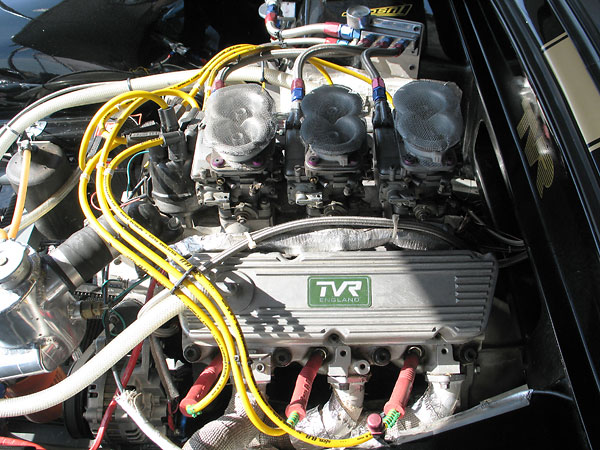
�
Cosworth GAA engine blocks offer many advantages over original Essex engine blocks, including 4-bolt
�
main bearings in lieu of 2-bolt mains. To meet class rules, bores were sleeved down from 100mm to 94mm.
�
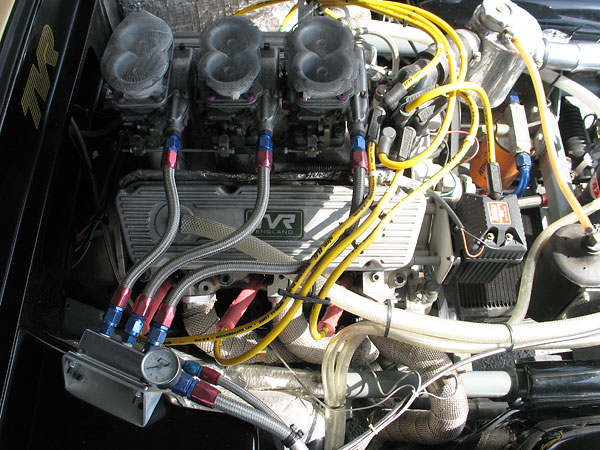
�
Mallory ProMaster coil. Accel 8.8 Silicone Plus, Spiral Core, RFI suppression spark plug wires.
�
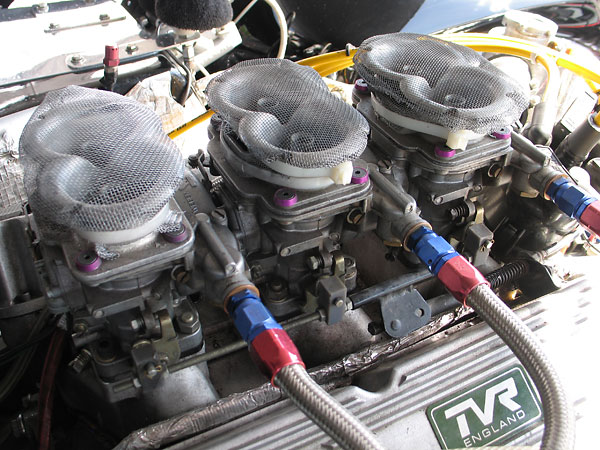
�
Triple Weber 44 DCNF downdraught carburetors, set-up as follows:...
�
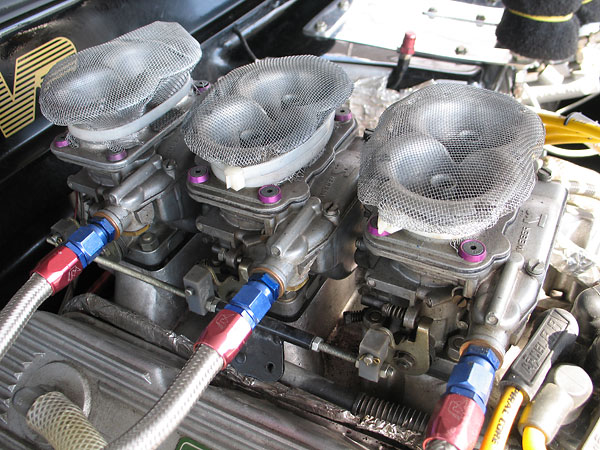
�
main venturi = 35, aux. venturi = 4.5, main jet = 1.40, air correction = 1.85, pump jet = 0.40.
�
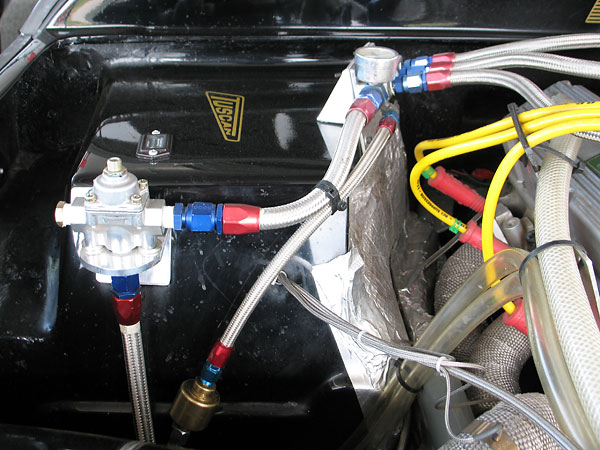
�
Below and the the right of the Holley adjustable fuel pressure regulator is an electronic sensor for
�
a dashboard mounted fuel pressure gauge. A Hobbes hour meter is mounted beyond the regulator.
�
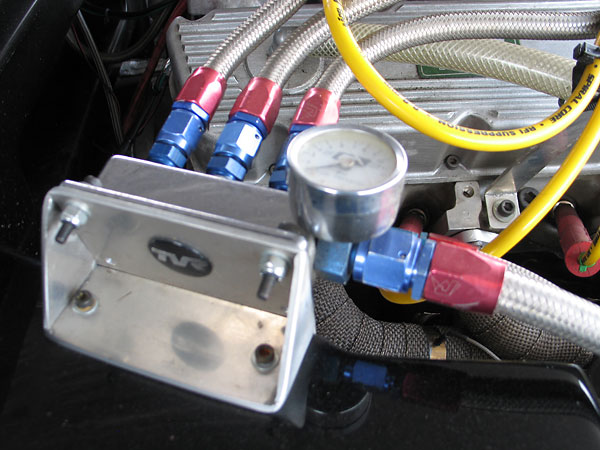
�
Mr. Gasket mechanical fuel pressure gauge (0-15psi), mounted to the Mr. Gasket triple outlet fuel block.
�
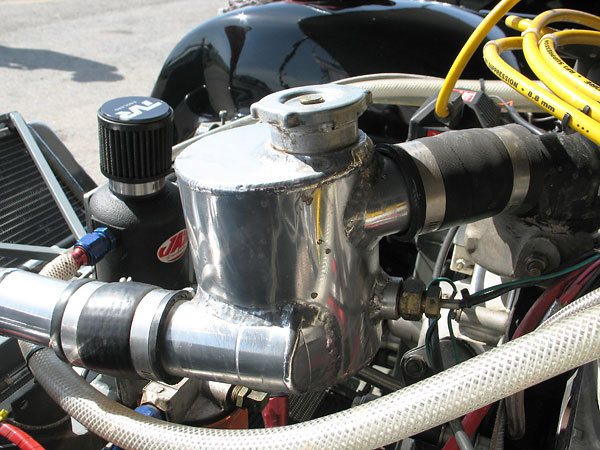
�
Fabricated aluminum coolant header tank.
�
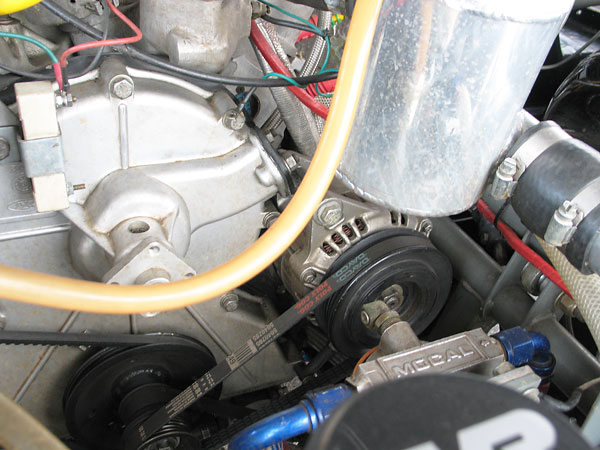
�
Mitsubishi alternator. Mocal remote oil filter with Fram HP1 filter.
�
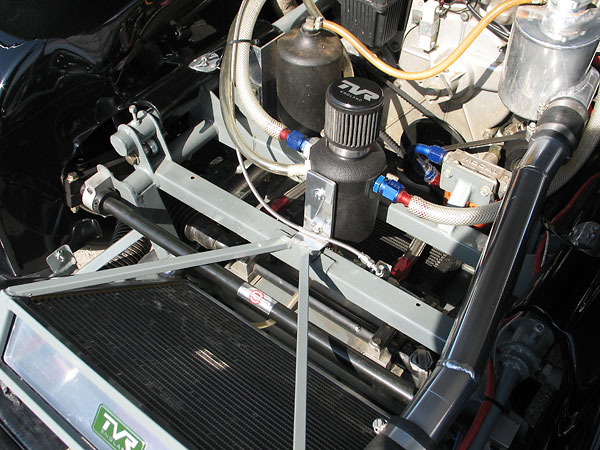
�
Jaz Products engine crankcase breather bottle.
�
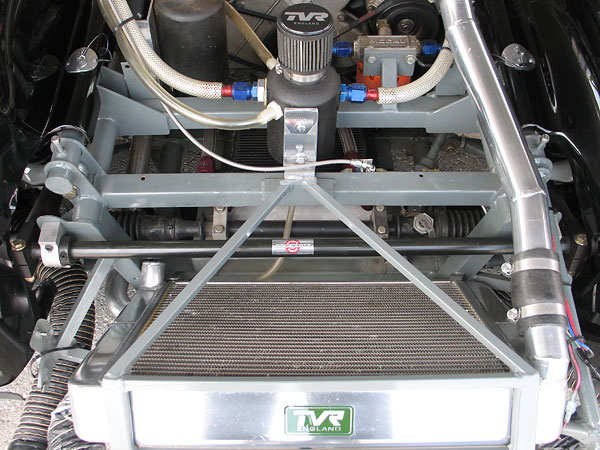
�
Custom Griffin aluminum radiator.
�
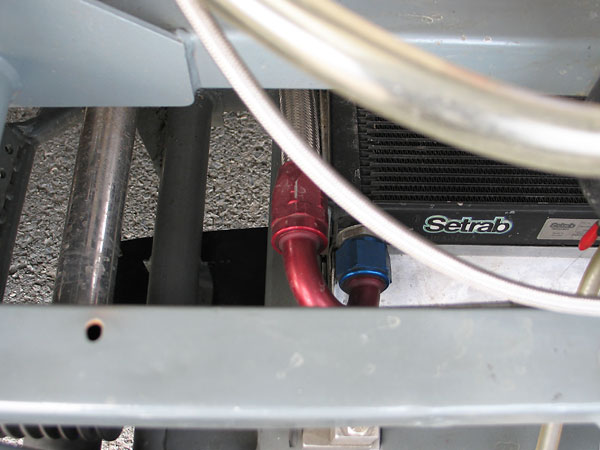
�
Setrab oil cooler.
�
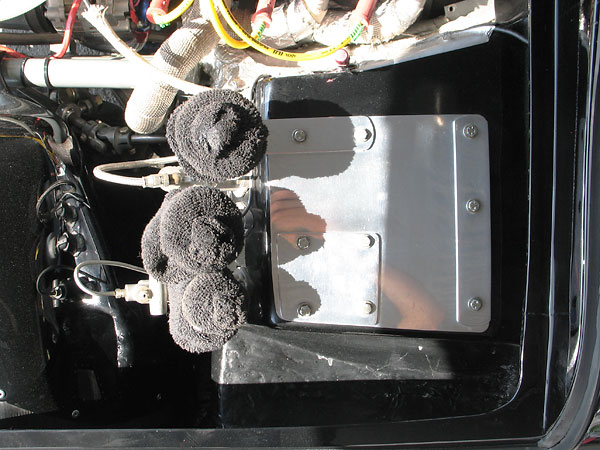
�
Dual Girling brake master cylinders, with remotely adjustable bias bar.
�
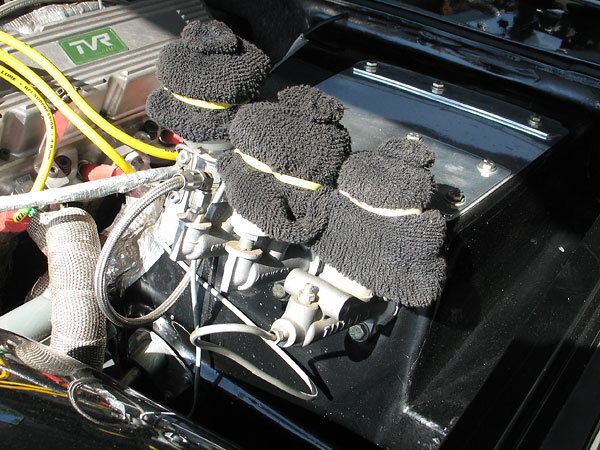
�
Tilton clutch master cylinder.
�
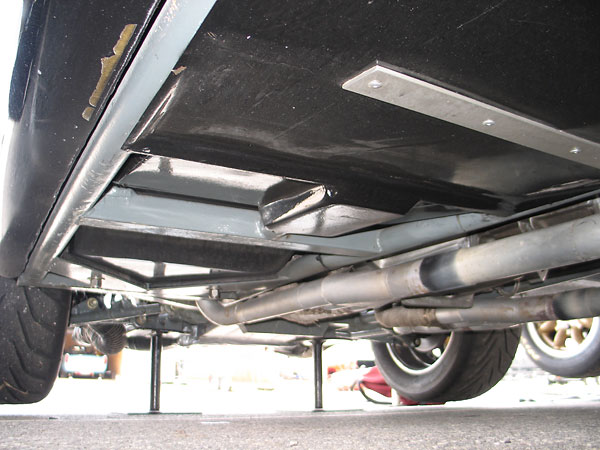
�
Mike Pierro custom fabricated exhaust headers with 3-into-1 collectors and slip joints.
�
Dual straight pipes exiting out the rear of car.
�
�
Front Suspension
��
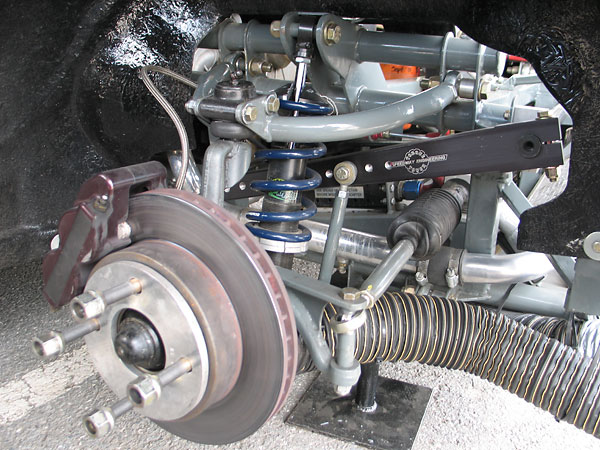
�
Spax Krypton adjustable gas coil-over shock absorbers with Hypercoil springs.
�
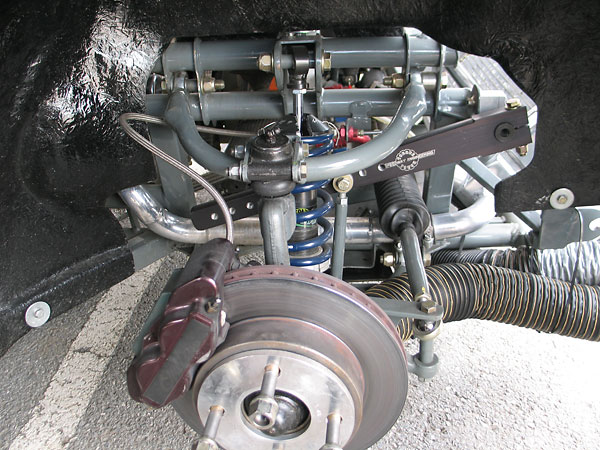
�
Outlaw four piston brake calipers with Hawk HP100 pads. 10.75" Ford Thunderbird rotors.
�
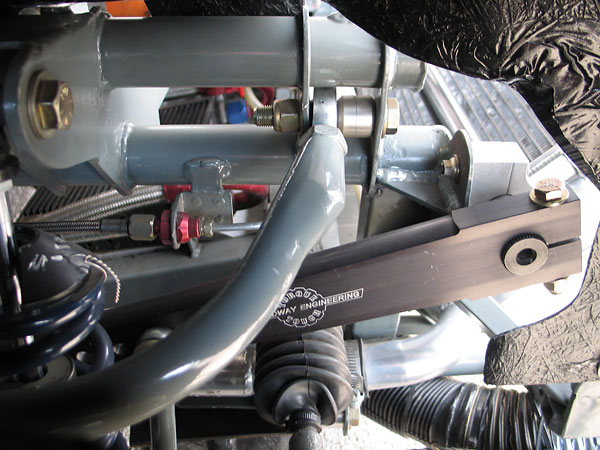
�
Speedway Engineering modular 1" adjustable sway bar, mounted on aluminum pillow blocks.
�
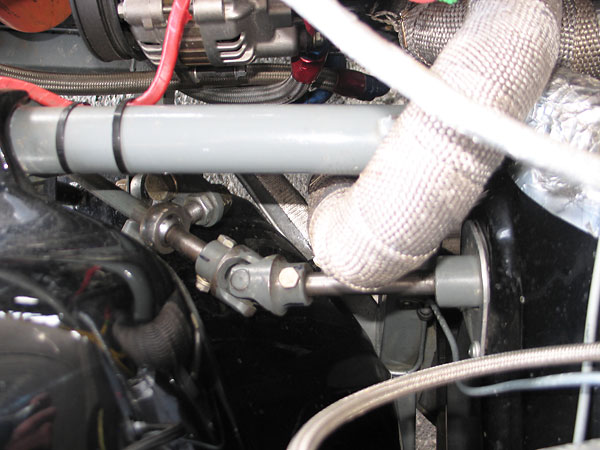
�
Upper steering universal joint.
�
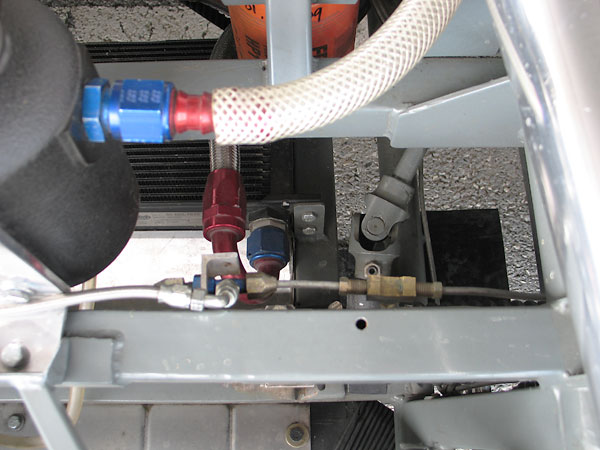
�
Lower steering universal joint.
�
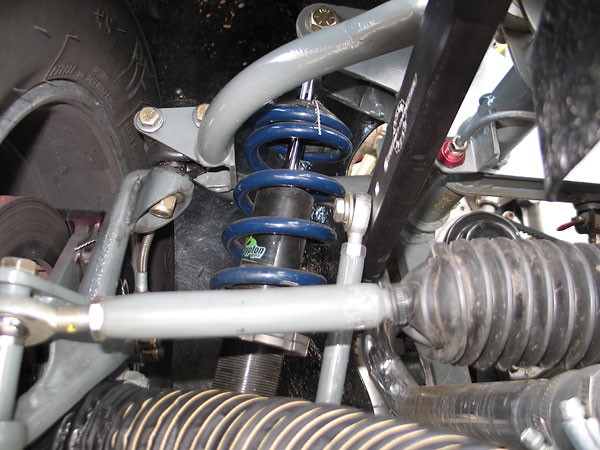
�
The connecting links of the Triumph TR6 competition (quick ratio) steering rack have been shortened
�
and modified to utilize male-threaded Heim joints in lieu of regular female-threaded tie rod ends.
�
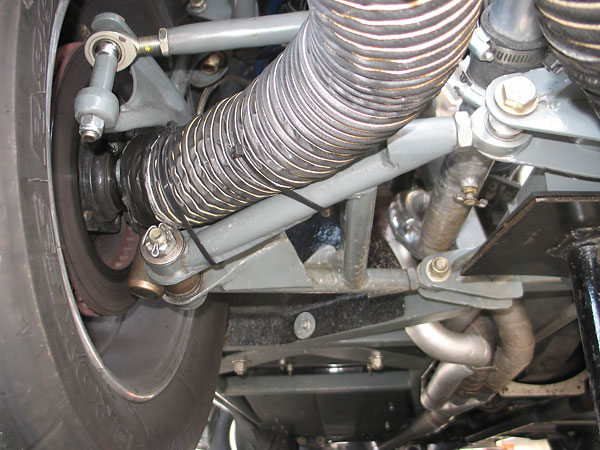
�
Steering arms have been substantially reinforced in a manner which also places Heim joint attachments
�
in double shear with spacers for simple attachment height adjustment (for eliminating bump steer.)
�
Background: three-into-one exhaust header collectors.
�
�
Enjoying this article? www.BritishRaceCar.com is partially funded through generous support from readers like you!
�
To contribute to our operating budget, please click here and follow the instructions.
�
(Suggested contribution is twenty bucks per year. Feel free to give more!)�
Rear Suspension
��
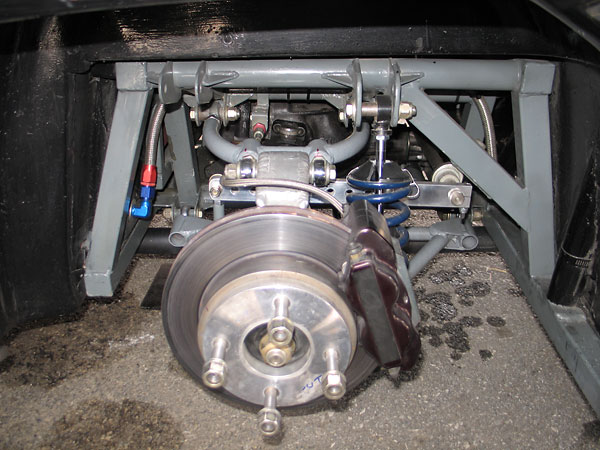
�
Custom engineered and fabricated independent rear suspension.
�
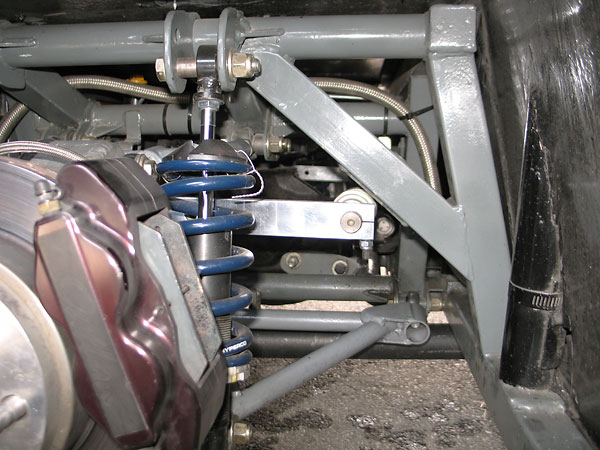
�
Spax Krypton adjustable gas coil-over shock absorbers with Hypercoil springs.
�
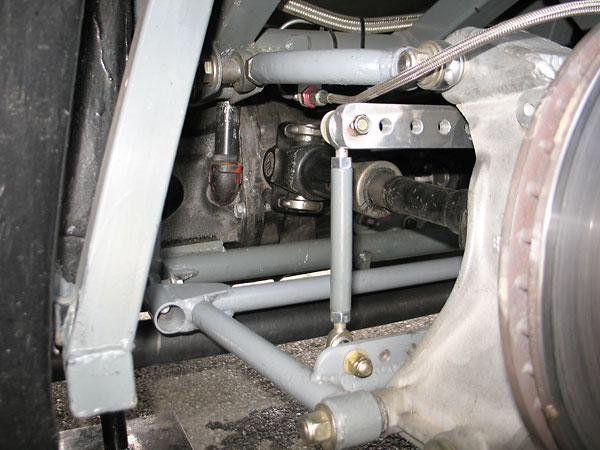
�
Speedway Engineering modular / adjustable anti-sway bar, shown at its softest setting.
�
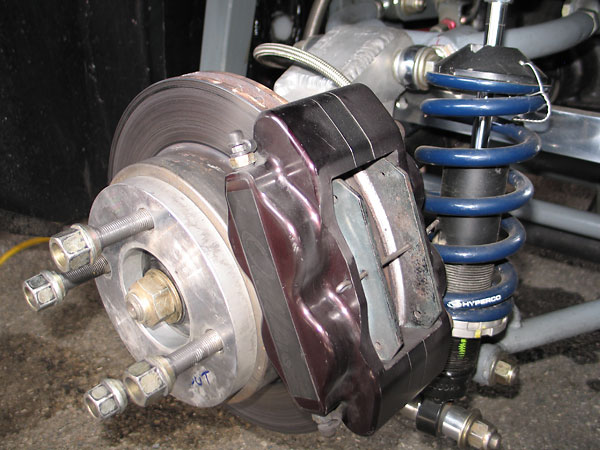
�
Outlaw four piston brake calipers with Hawk HP100 pads. 10.75" Ford Thunderbird rotors.
�
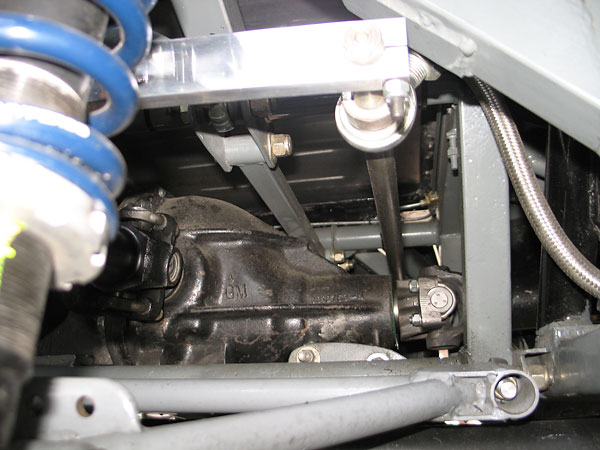
�
Chevrolet Corvette quick change rear end with limited slip differential.
�
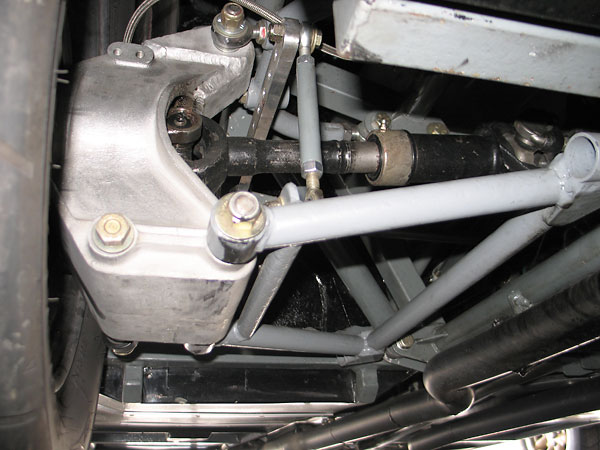
�
Reinforced aluminum hub carriers. Custom heavy-duty half shafts with machined M-21 universal joints.
�
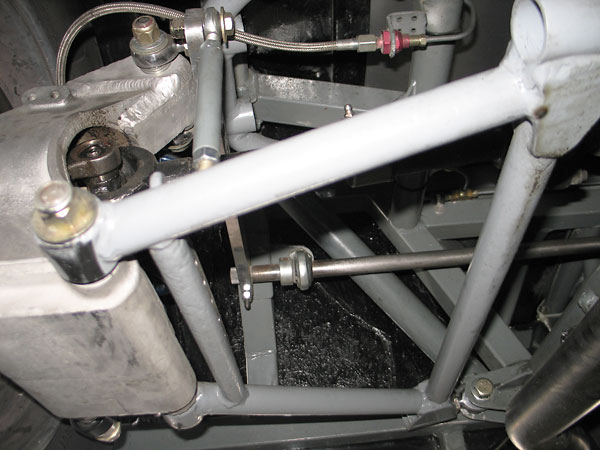
�
Notice that the rear anti-sway bar is mounted to the body via Heim joints instead of pillow blocks.
�
�
Interior / Roll Structure / Etc.
��
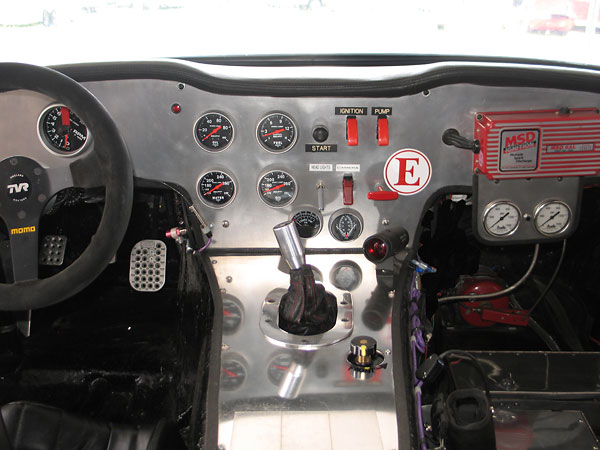
�
AutoMeter Sport-Comp tachometer (0-10000rpm), oil pressure (0-100psi), fuel pressure (0-15psi),
�
coolant temperature (140-280F), and oil temperature (140-280F) gauges.
�
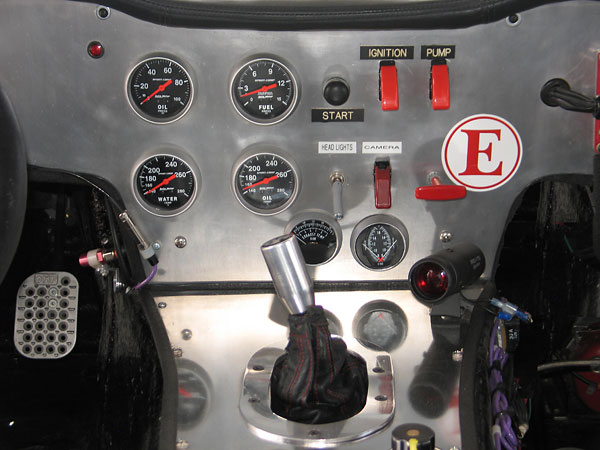
�
Bottom row: Westach single EGT (700-1700F) and dual EGT (700-1700F) gauges. To the right: an
�
AutoMeter Pro-Lite warning light would alert the driver in the event of loss of engine oil pressure.
�
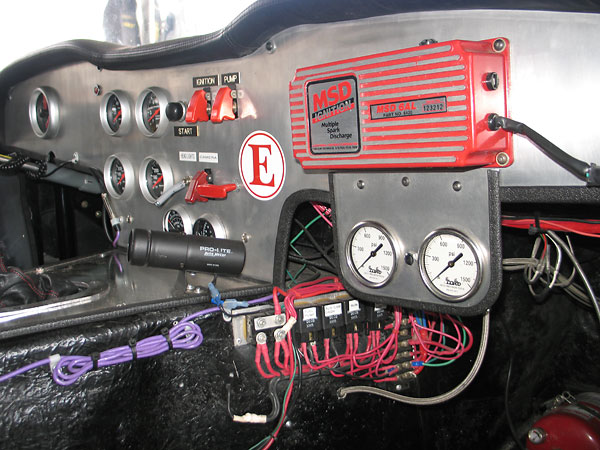
�
Mico brake pressure (0-1500psi) gauges mounted underneath an MSD6AL multiple spark discharge
�
electronic ignition controller. (At Summit Point, the MSD's rev limiter was set at 7200rpm.)
�
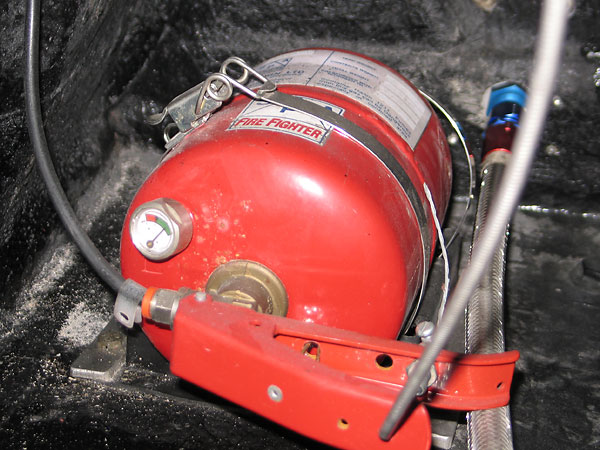
�
SPA Firefighter cable-actuated AFFF (foam-type) fire suppression system.
�
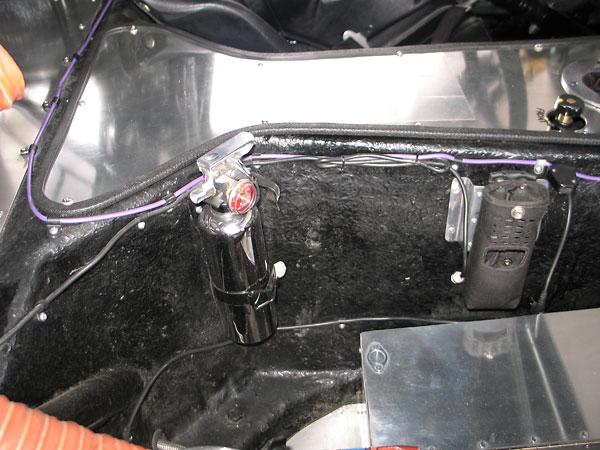
�
Handheld fire extinguisher.
�
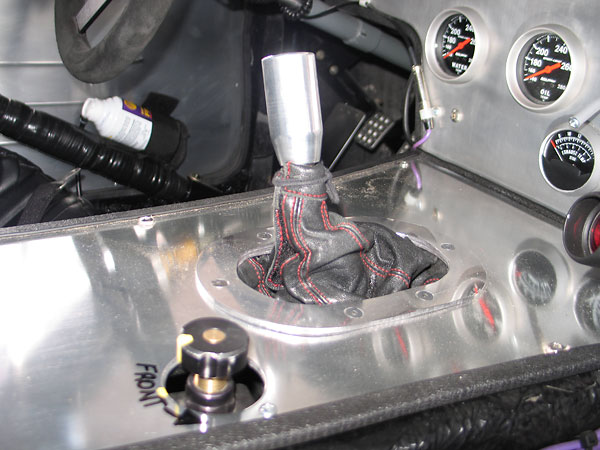
�
Foreground: Tilton brake bias valve.
�
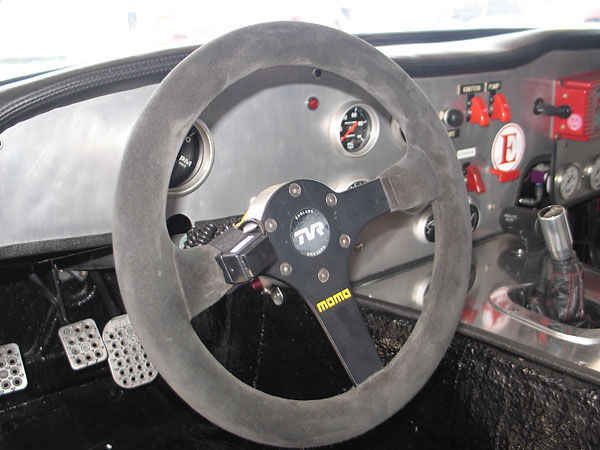
�
Momo suede-covered steering wheel. (Pushbutton on left spoke is for the two-way radio's microphone.)
�
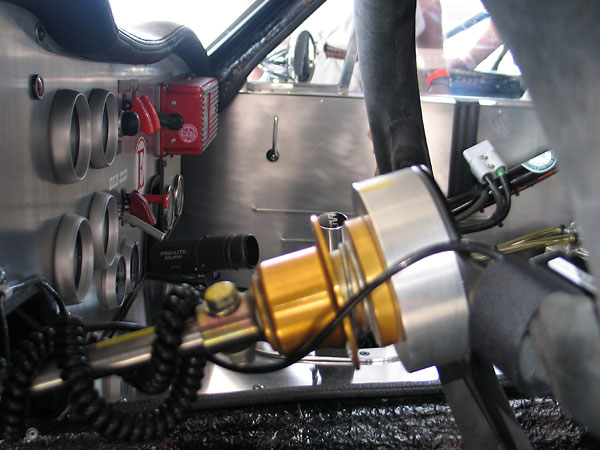
�
Pegasus hex type quick release steering wheel hub.
�
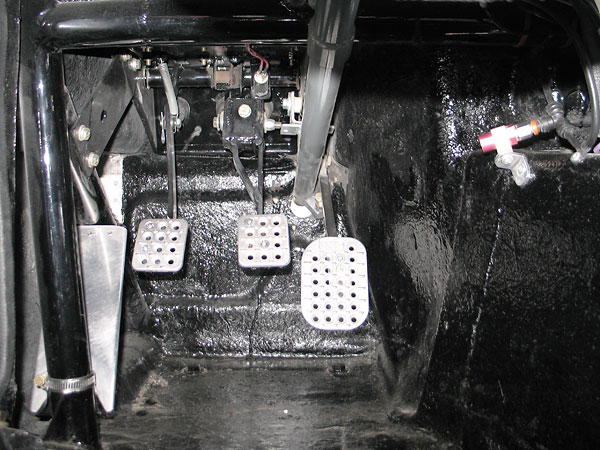
�
OMP cast aluminum pedal pad kit.
�
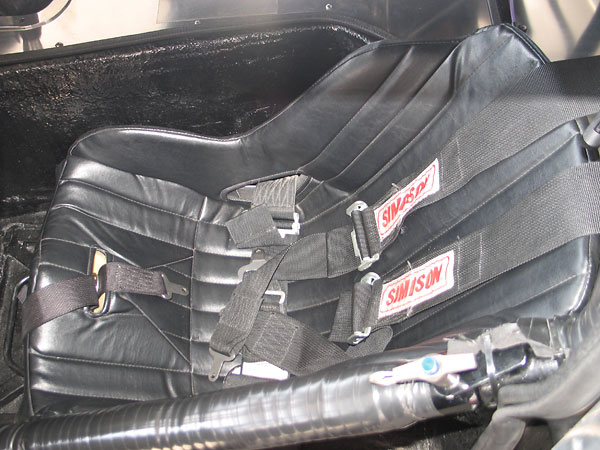
�
Kirkey 41V low back aluminum drivers seat, with Simpson 5-point cam-lok safety harness.
�
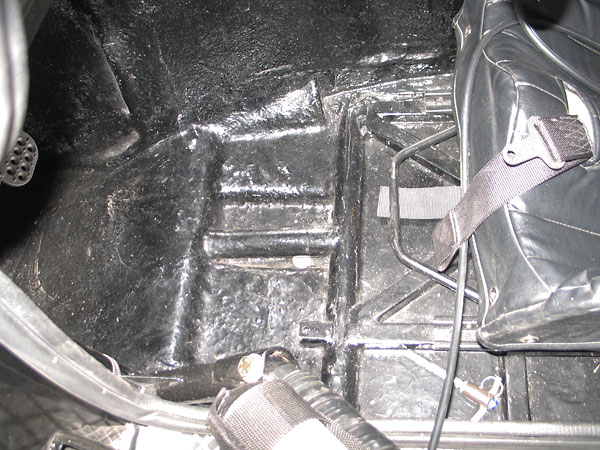
�
Floor reinforcements for drivers seat. Note that the seat is mounted on adjustable sliders.
�
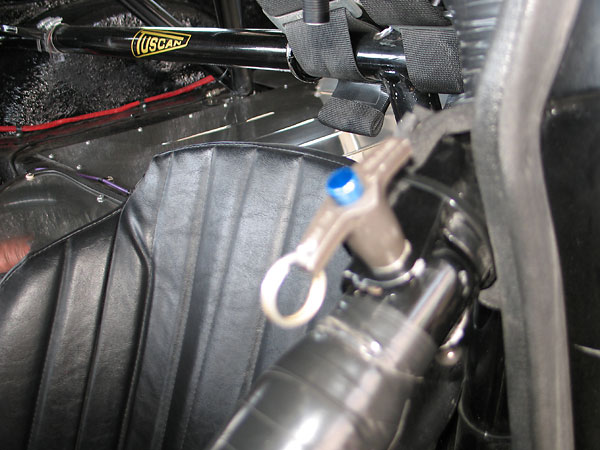
�
Driver's side door brace is hinged for easier egress. When racing, it's secured in place with a pip pin.
�
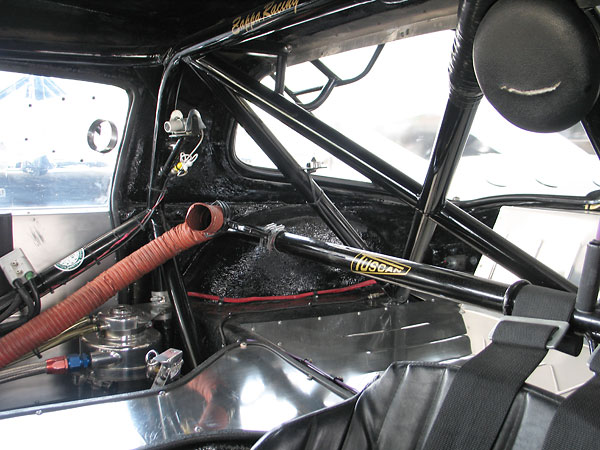
�
Shoulder harness straps wrap around a well-placed roll cage bar. (This is the best attachment method.)
�
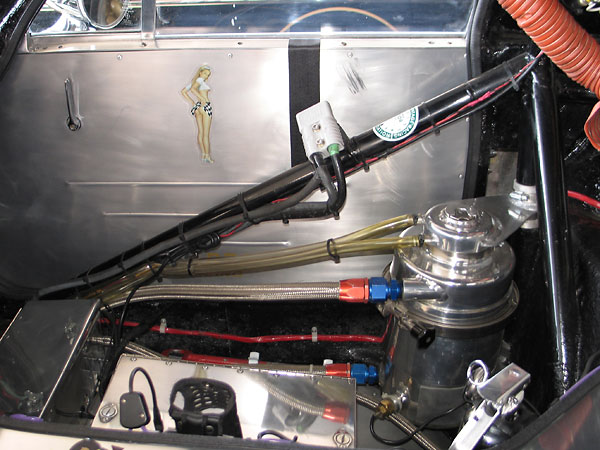
�
The oil reservoir for the engine's dry sump lubrication system was provided by Ric Wood Motorsport.
�
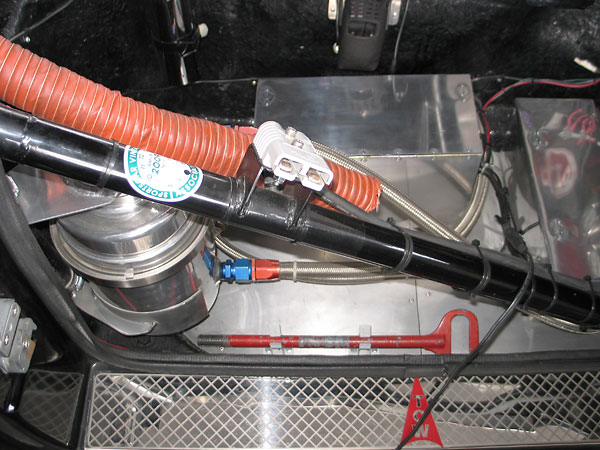
�
Foreground: quick connection for jump starting. Below: detachable tow hook.
�
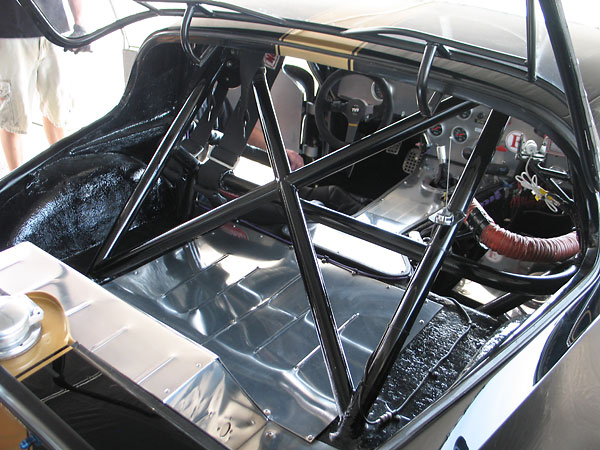
�
An ATL 8 gallon fuel cell is mounted under aluminum panels.
�
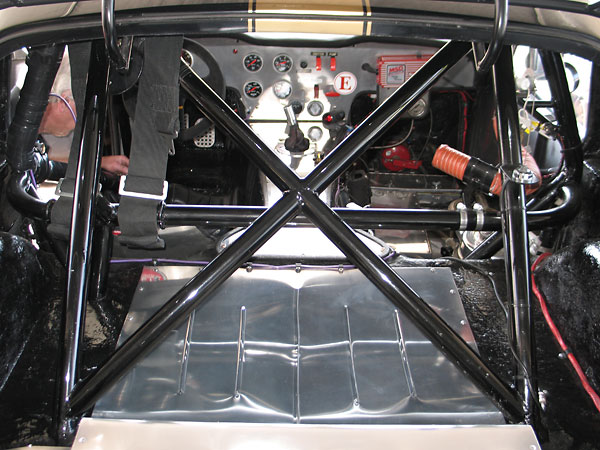
�
The fully-operable rear hatch was entirely custom fabricated. It provides great access for fuel system service.
�
�
Exterior
��
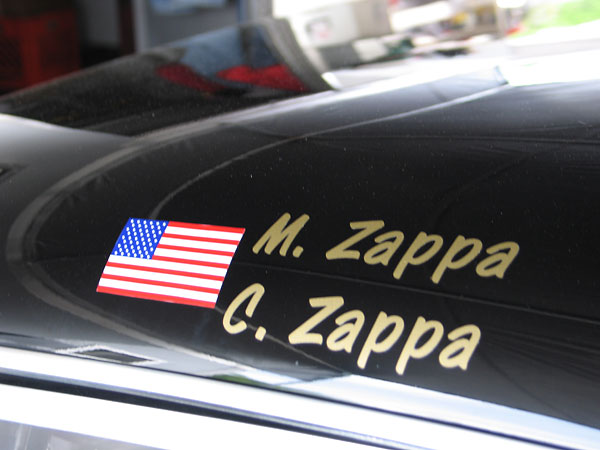
�
Michael Zappa and Chris Zappa comprise a father-and-son team.
�
At the 2010 Jefferson 500, Mike drove the family's MGB and Chris drove their TVR.
�
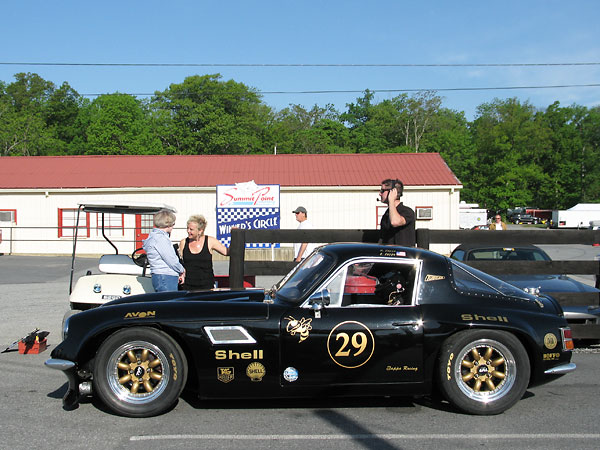
�
Chris Zappa prepares for Saturday's Group 2 Sprint Race. He would finish third overall of twenty cars,
�
with a best lap time of 1:25.762 (83.95mph average) around the technically challenging 2.0 mile circuit.
�
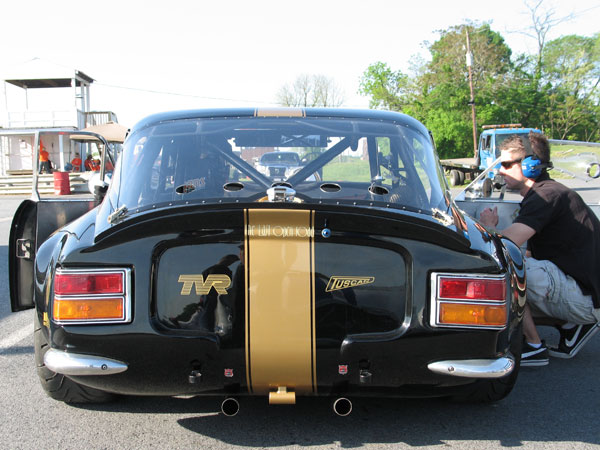
�
Jordan Fate helps out at every race. At Summit Point, the Zappa Racing team roster included: Mike (dad),
�
Beth (mom), Chris (son), Jim and Dianne Boffo (of Boffo Motors), and friends Jordan and Rege Fate.
�
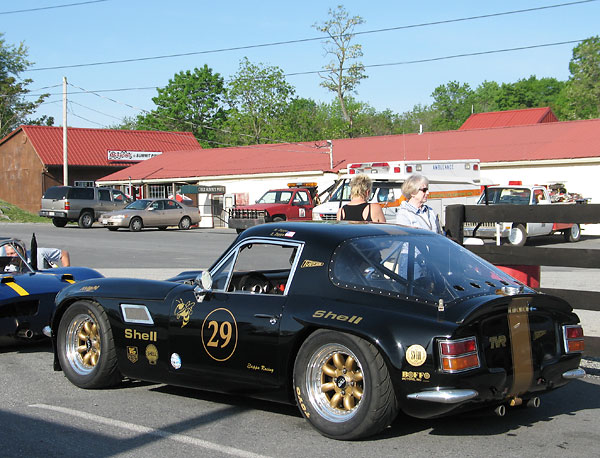
�
Both front windscreen and rear window have been custom molded out of clear polycarbonate sheet.
�
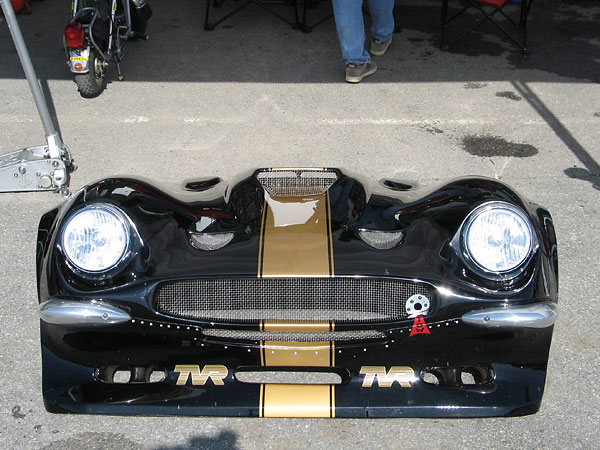
�
The fiberglass front clip assembly is lightweight and easily detachable. Mike Pierro created it, mostly
�
from scratch, but using some bits from an old Lotus Cortina Trans-Am racecar. Jim Boffo further modified
�
the front clip for additional tire clearance. He cut the fenders longitudinally behind the headlights,
�
rotated them outward, and spliced them back together. Note also the provision for a detachable tow bar.
�
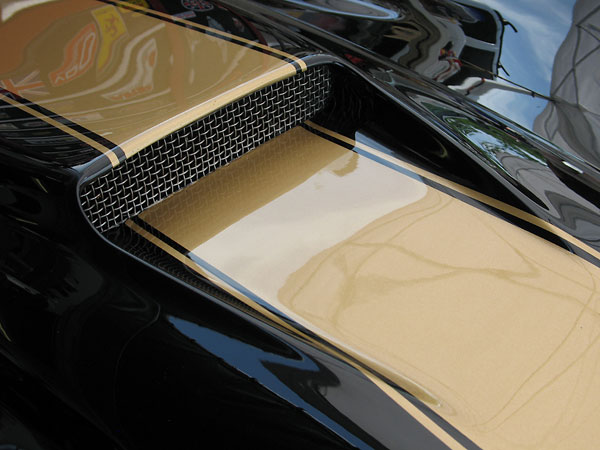
�
The hood scoop was also by Mike Pierro, who created it by molding off of a 1986 Mustang SVO.
�
(On the Mustang SVO, it provided airflow to a top mounted intercooler.)
�
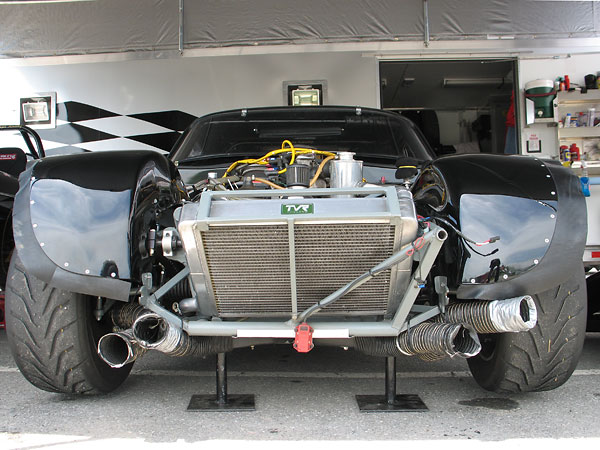
�
Ducts from the front clip's integral air dam supply airflow to the engine oil cooler and brakes respectively.
�
(Note: the red electronic device at center is a transponder for the track's timing and scoring system.)
�
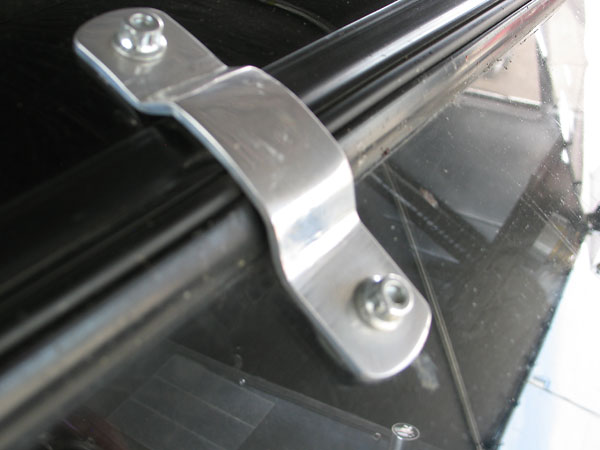
�
Aluminum windshield hold-downs supplement the rubber grommet.
�
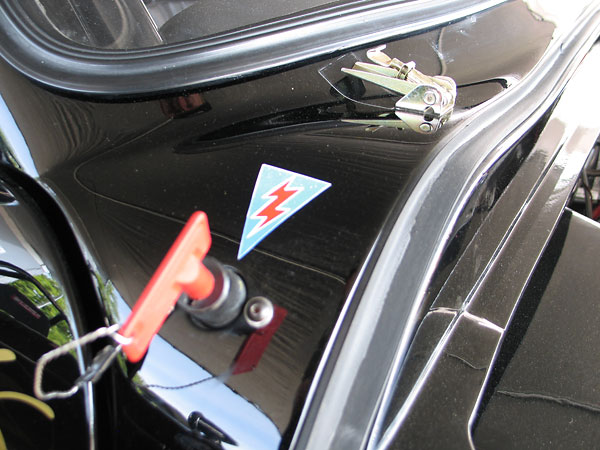
�
Hella battery disconnect switch.
�
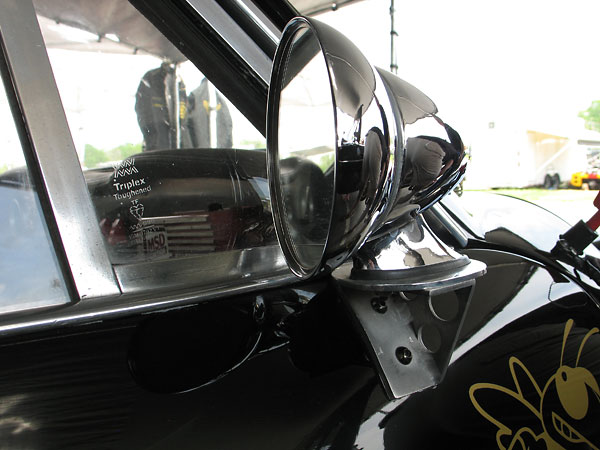
�
Raydyot large bullet mirrors on custom fabricated aluminum brackets.
�
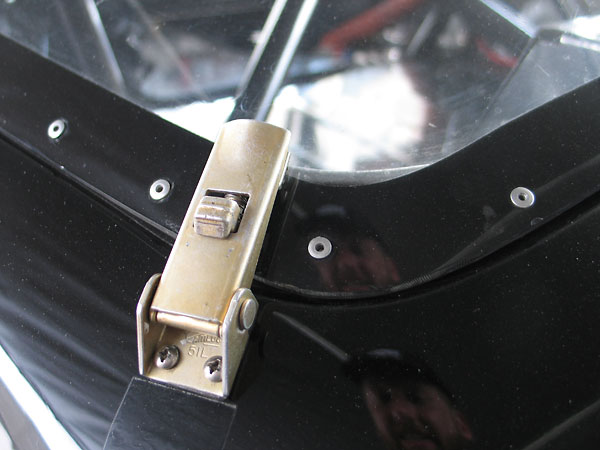
�
Camloc 51L medium duty tension latches (with secondary locks) hold down the rear window.
�
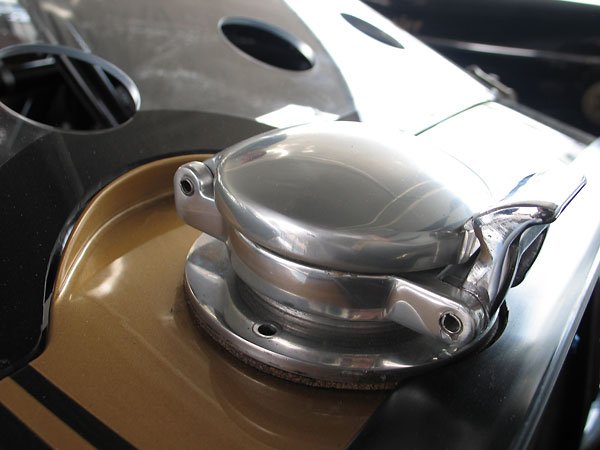
�
An original Aston Martin LeMans-style fuel filler cap has been installed.
�
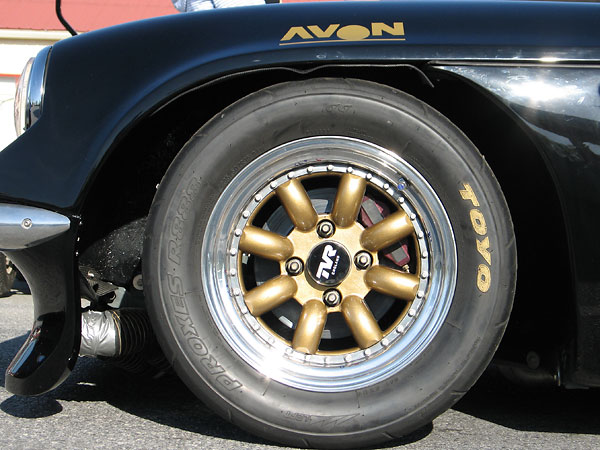
�
3-piece aluminum racing wheels by Image Wheels International Ltd. of Great Britain.
�
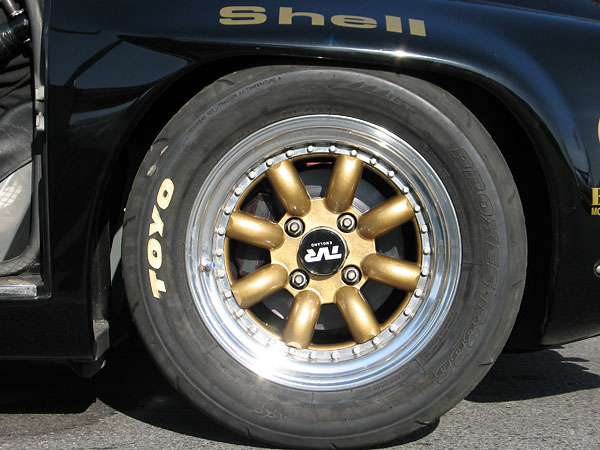
�
Toyo Proxes R888/235/50/15 tires, unshaved.
�
�
All photos shown here are from April 2010 when we viewed the car at VRG's Jefferson 500�
at Summit Point Motorsports Park, West Virginia. Photos by Curtis Jacobson for BritishRaceCar.com, �
copyright 2010. All rights reserved.
�
| If you liked this article, you'll probably also enjoy these: | �|||||
 | �
Michael Zappa 1962 MG MGB | �
 | �
Dennis DeLap 1967 TVR 2200 Special | �
 | �
Bob Polak 1969 Mini Marcos | �
| You're invited to discuss anything you've seen here on The British Racecar Motorsports Forum! | �|||||
�
Notice: all the articles and almost all the photos on BritishRacecar.com are by Curtis Jacobson.
�
(Photos that aren't by Curtis are explicitly credited.) Reproduction without prior written permission is prohibited.
�
Contact us to purchase images or reproduction permission. Higher resolution images are optionally available.
�

 �
�